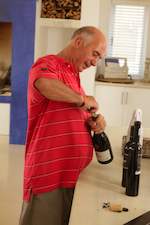Beyerskloof started off as a bit of an underdog too, and in 1987, when Beyers Truter the cellarmaster, followed up on a newspaper advertisement for a small Stellenbosch farm on the R304 overlooking the Simonsberg. He found a dilapidated house, a run-down cellar last used in 1955 to make distilling wine, and remnants of neglected pinotage, cabernet and cinsaut vines. 'And there was a donkey called Peanuts, and a few ducks...'

At the Diners Club Winemaker of the Year award function that same year, he'd mentioned what he thought was a rather unrealistic dream of owning his own piece of Stellenbosch soil to then head of Diners Club SA Hugh Peatling. Peatling mustered some other wine-loving investors to back the award-winning winemaker.
Contrary to popular perception, Beyerskloof is not named after the vintner. Although a canny marketing man whose larger-than-life personality and active wine industry involvement naturally attracts publicity, he is of inherently humble nature.
The farm was called Les Croisettes. But he discovered that the entire area across the foothills to the Simonsberg had once been farmed by the Beyers family, of which he was a sixth-generation descendant.
'There's a ravine just behind Kanonkop called Beyerskloof, which is where I got the name. Paul Benade, then owner of nearby Lievland, subsequently brought me an old collector's bottle of wine made under the Beyerskloof label by the former owners of Lievland. He said I was welcome to use the name: for an annual payment of a case of wine!' Initially, he ran Beyerskloof as a tiegociant business, buying grapes and wine. His mission to find old bush vine pinotage in Stellenbosch was a pioneering effort. So too was his vinification of a different style of pinotage to the rich, more seriously oaked exponents the Cape was becoming known for: a fresh, fruit-driven, easy-drinking wine, partially barrel-matured for just six months, sometimes with a dash of cabernet or merlot added, primarily for export to the UK, where it was lapped up.
Initial plantings of five hectares of merlot and cabernet expanded to nearly 100 hectares of main pinotage (including bush vines), cabernet and merlot. A small, boutique wine cellar was built to handle up to 400 tons.
'I always like to give myself at least 10 years to work on something before feeling that I've achieved my best. '
When Beyers Truter found another property on the other side of the Bottelary hills, Bouwland was purchased and planted to nearly 70 hectares of predominantly pinotage, cabernet and merlot. Besides supplying Beyerskloof (and Kanonkop) with grapes, it was also intended to provide an opportunity for the workers on all three farms to start their own wine venture.
Beyers, continuing in the vein of a supporter of the underdog, spent about a decade from 1995 to 2005 actively involved in local government. He and his similarly socio-politically engaged predecessor at Kanonkop, Jan 'Boland' Coetzee, joined farm community leaders to form the 'Tractor Party', then the Alliance of the Community for which he held one of two seats in the Stellenbosch town council.
He eventually became an African National Congress councillor, until the country's ruling party lost a local by-election to the main opposition, the Democratic Alliance, and he withdrew from politics.
 Beyers Truter minced alikreukel (giant periwinkles) in pinotage with Frank’s saffron rice recipe paired with Beyerskloof Pinotage....
Beyers Truter minced alikreukel (giant periwinkles) in pinotage with Frank’s saffron rice recipe paired with Beyerskloof Pinotage.... Rib-eye steak with pinotage sauce and mieliebrood (cornbread) recipe by Beyers Truter....
Rib-eye steak with pinotage sauce and mieliebrood (cornbread) recipe by Beyers Truter....